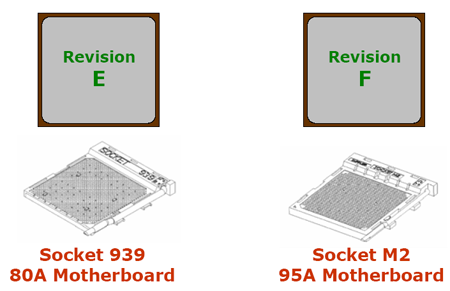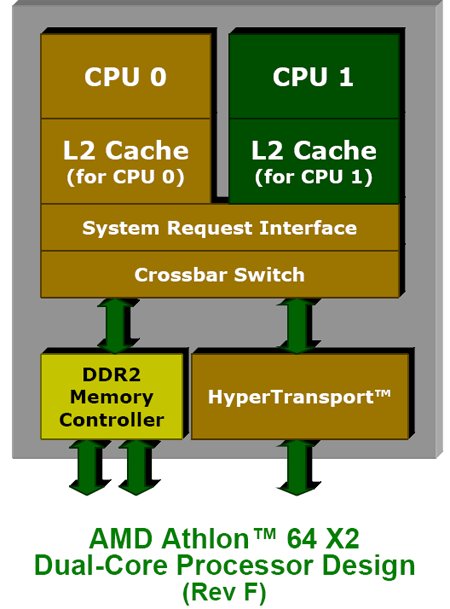Q3'05 AMD Roadmap; DDR2 and New Sockets for AMD
by Kristopher Kubicki & Jarred Walton on July 21, 2005 1:47 PM EST- Posted in
- CPUs
AMD CPU Roadmap Update
We haven't updated our AMD roadmap for a few months, in part due to overlapping NDAs and product launches. Unfortunately we are just about to go under NDA for AMD's next low clock X2 processor - but rather than postpone another roadmap we decided to carry on just without that information. Our last detailed AMD roadmap was actually back in December, and we have quite a bit of new information to cover. We'll focus primarily on the upcoming parts, which will be highlighted in red in our tables, but we'll also list details on many of the currently shipping parts. Let's start with the desktop sector.
Introducing M2
The big news of course is the upcoming transition from socket 939 to socket M2. M2 will have 940 pins, and while the actual layout of motherboards with the new socket will be very similar to socket 939, processors will obviously not be pin compatible. The same goes for current socket 940 processors: they won't work or fit in socket M2. That makes sense, considering that M2 will require the use of DDR2 memory. The similarity in layout will allow motherboard makers to quickly adapt 939 designs to M2, however.
Initially slated to support up to DDR2-667, the socket M2 processors will launch in the second quarter of 2006. Codenamed Orleans for the single core processors, the roadmaps include few details on the clock speeds or cache amounts of the new parts. Without speculating too much, we would assume that the specifications will be the same as equivalent 939 processors, but we could be wrong. Another possibility is that the DDR2 parts will outperform the socket 939 parts, allowing AMD to modify their names (again). Either option seems equally likely, and we wouldn't be surprised to see the 4000+ M2 ship as a 2.6 GHz 512K part, as that would allow the use of a single design for the three listed chips.

Processors running on the new M2 socket are dubbed Revision "F". Revision "F" processors carry all the features of existing "E" CPUs, but along with the new socket comes some significant changes in power. For example, a typical Revision "E" San Diego Athlon 64 utilizes 80 amps with a maximum TDP around 90W. The new Revision "F" CPUs will use 95 amps instead. However, although the processors require a bump in the current, the power remains the same. Unfortunately, expect massive increases in TDP. From the roadmap we expect the FX M2 processors to have a max TDP of 125W, 110W for dual core and 104W for single core. Revision "F" implements a new Bi-Directional PROCHOT so that the motherboard can throttle the processor dynamically, but the CPU can also override and throttle itself if necessary.

The main changes to the processor diagram only appear to be the integrated DDR2 controller instead of the integrated DDR1 controller.










51 Comments
View All Comments
KristopherKubicki - Sunday, July 24, 2005 - link
Zebo: We are doing desktop tests; so yes everything is the same but the motherboard.Kristopher
Zebo - Monday, July 25, 2005 - link
Kris- That's pretty lame. How's that supposed to give a notebook buyer a clue using desktop motherboards and desktop chipsets?? The whole idea with centrino is it's platform..low power chipset and mobo and chip. AMD same deal with "Turion 64 mobile technology" their complete platform. I want to see how those techs compete with one another not those chips in hacked desktop setup which only works with 1 or 2 motherboards.Not only that Anandtech has done at least 7 Pentium M notebook reviews by my count, is'nt it a bit irresponsible not to have done even one with it's direct competitor?
Lame-- GamePC lame.
KristopherKubicki - Monday, July 25, 2005 - link
We have other mobility only reviews scheduled as well. This is just a comparison of the two chips on the desktop.Kristopher
Zebo - Monday, July 25, 2005 - link
Well Kris (i can call you Kris right:)) I just don't get doing yet another desktop preview of pentium M. I mean you have like 3-4 of them out now in a couple part series and with a .. 855 and the asus adaptor. We know how it performs in the limited desktop. We also know how turion performs for the most part from two years ago in tens of 754 reviews and you had a couple 754 chips inside those very same Pentium M reviews.What I'd like to see is the compete platform technology, done by a thorough site like anandtech using same equiped notebook parts then see how they stack up. No one one has done one yet (at the AT quality level) which is totally bewieldering to me.. not to compare direct competitors in a market which saw sales higher than the desktop first time last month.
Zebo - Tuesday, July 26, 2005 - link
BUMPJarredWalton - Tuesday, July 26, 2005 - link
Zebo - any specific laptop that you'd suggest? I'm not the mobility reviewer, but I can at least put the word out to the others and see what happens. Part of the problem is that non-Pentium M laptops are often billed as more affordable solutions, including the Turion systems. If the battery size is significantly smaller on a Turion, it doesn't really make it a better mobility laptop.Looking at power requirements, which are now 25W for the low power Turion/Athlon 64-M and 22W for the Pentium M, you can pretty much say that all other things being equal, battery life should be similar. Unfortunately, rarely are the other things equal - different screen is a big one, but different battery, HDD, RAM, GPU, etc. will all have an impact. Until someone comes out with a Turion notebook specifically tailored to compete against the high-end mobile Pentium M notebooks, getting anything resembling an apples to apples comparison will be difficult. (Which of course is why I ask for a suggested Turion notebook.)
Zebo - Sunday, July 24, 2005 - link
I'm definity not buying one of these new X2 chips.. Throttle?? No thanks! Even having that potential bugs me to no end. I'd rather burn my chip than throttle. I want Mhz I paid for, not what they feel like giving meNot only that DDR right now is hitting 2-2-2 @270Mhz which DDR2 has no hope the trump.
Then the whole tin foil thing- converting your Personal Computer(PC) into a corporate-controlled terminal(CCT).
Zebo - Sunday, July 24, 2005 - link
The cnet article linked did just that and disagrees with your conclusion.. How do you explain this discrepancy?Performance was split, battery life was within 2% of one another.
Zebo - Sunday, July 24, 2005 - link
Jarred please stop quoting TDP's. Thier highly erronous MANUFACTURES numbers, which should be taken with a grain of salt. You don't use MANUFACTURES benchmarks why use thier power numbers? For example:AMD says X2 has a TDP of 110W while Xbit measured 96W from the 4800+.
Intel says P4E 670 has a 112W TDP Xbit measured 162W!!!
http://www.xbitlabs.com/articles/cpu/display/penti...
Same story everywhere. Intel signifigantly under rating thier TDP while AMD not only overrating it, but applying that number to almost every chip in the series. Even the lower clocked and less cache ones to that over rated number.
Test it, dont quote it.
Kris: Same battery (mAh), same screen, same hurtz lancaster/M or Sempy/cele , same HDD, Same video card, and same DVD I hope?
JarredWalton - Monday, July 25, 2005 - link
Wow... gonna have to get used to the change. :pAnyway, we don't really have an accurate and reliable way of measuring TDP for ourselves. The change from 80Amp to 95Amp is pretty surprising, though whether it's just a spec change for future stuff or a real change at present is impossible to say. If you can give me an accurate way of measuring TDP on our own (without exotic tools), I'd love to hear it. At present all we can usually do is plug the system into a wall socket device that measure total system power draw. You're right, though: take the TDP with a healthy helping of salt. :)